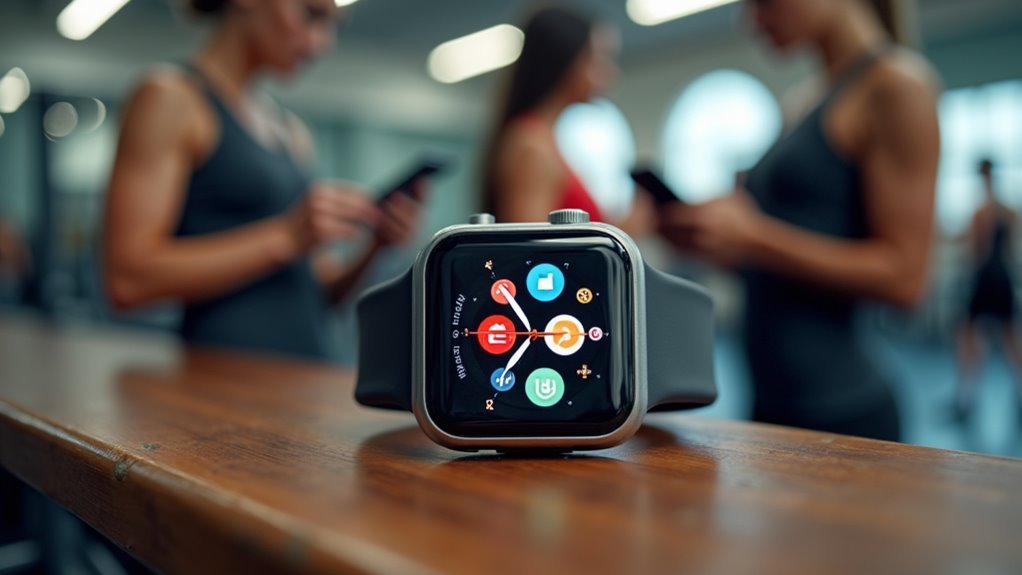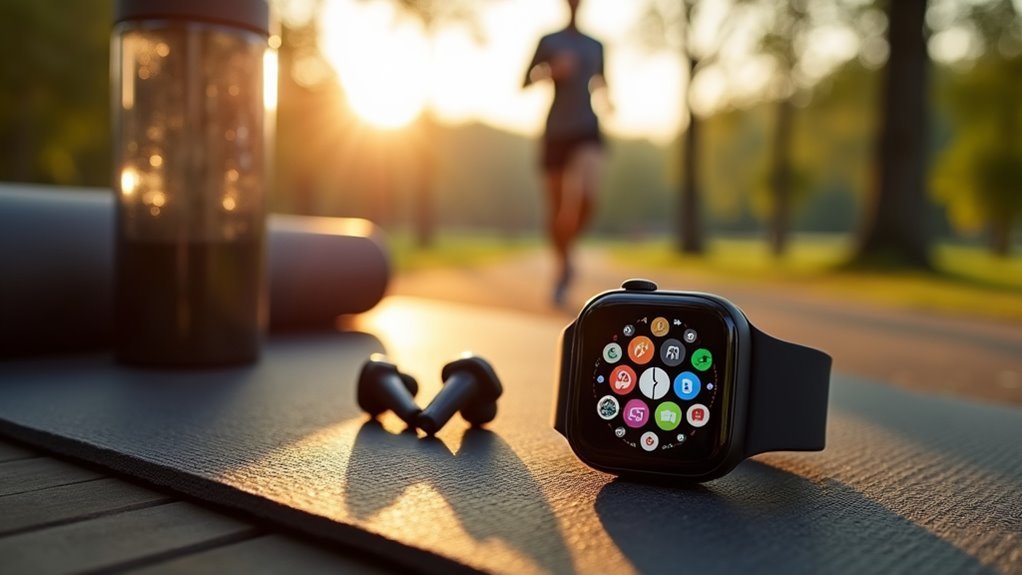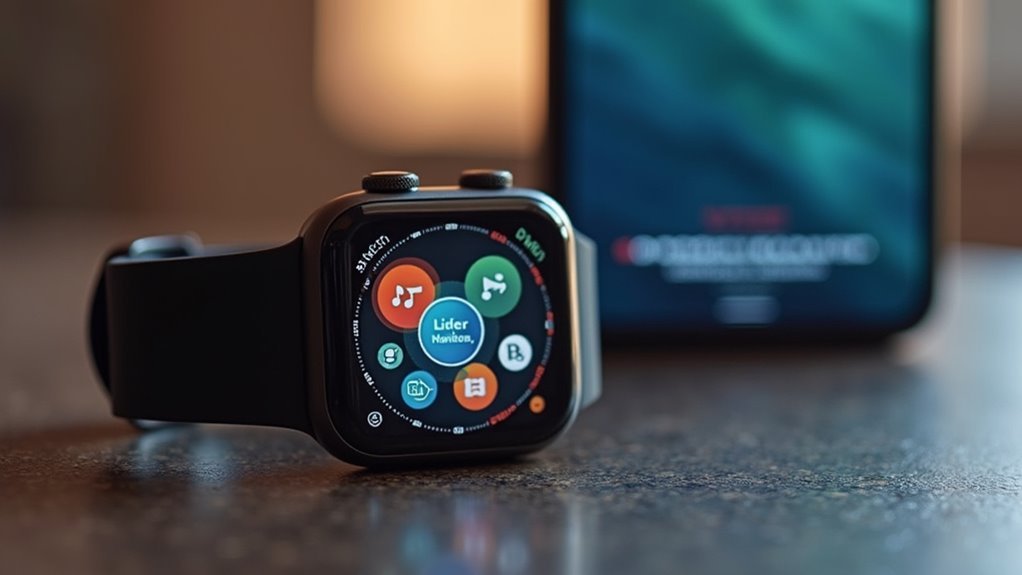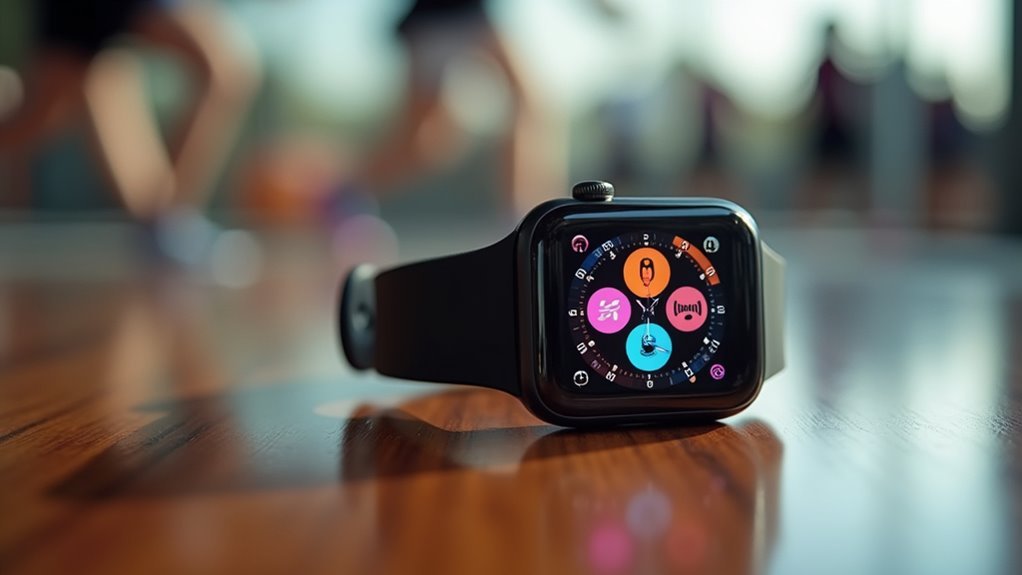Sport watches include multiple music apps because you’ll want different streaming services depending on your preferences, geographic location, and subscription choices. Since Spotify dominates with 31.7% market share while Apple Music and YouTube Music serve different user bases, manufacturers can’t rely on just one platform. You’ll also benefit from varied offline storage capabilities, cross-platform compatibility, and diverse user interfaces that each app offers, giving you maximum flexibility during workouts and ensuring there’s much more to discover.
Platform Compatibility Across Different Ecosystems

When choosing a sport watch with music capabilities, you’ll quickly discover that platform compatibility creates significant barriers between different ecosystems.
Apple Watch’s closed ecosystem exclusively supports iOS devices, making it incompatible with Android smartphones due to iOS-specific pairing protocols and technical limitations. You can’t access Apple’s HealthKit, Fitness App, or integrated services like Apple Pay if you’re using Android.
Apple Watch users remain locked into iOS, unable to pair with Android devices or access core Apple services outside the ecosystem.
Conversely, Wear OS by Google provides broader Android compatibility with various music and health app integrations. However, you’ll face cross-platform challenges maintaining app consistency across different operating systems.
Samsung Galaxy Watches offer strong Android ecosystem integration as an alternative. The Galaxy Watch 6 provides LTE connectivity and supports multiple streaming platforms including Spotify, YouTube, and Amazon Music with 16GB storage for MP3s.
This ecosystem lock-in means you’re often restricted to your platform’s native apps, limiting your choices and forcing manufacturers to develop multiple versions for different operating systems.
Offline Music Storage and Playback Capabilities
You can download entire playlists directly to your sport watch’s internal storage, eliminating the need to carry your phone during workouts.
This feature transforms your watch into a standalone music player that works without internet connectivity, though you’ll face storage limitations and compatibility challenges. Storage capacity ranges from 4 GB in models like the Garmin Venu Active 5 to 64 GB in the Apple Watch Series 9, significantly impacting how much music you can store offline.
The technical implementation varies considerably across different watch models, affecting everything from supported file formats to battery performance during playback.
Download Playlists Directly
How convenient would it be to download your favorite playlists directly to your sport watch without needing your phone during workouts?
Unfortunately, most sport watches don’t support direct playlist downloads from major services like Spotify or Apple Music. Apple Watches require external services like Apple Music, while Fitbits use their own music app without Spotify integration.
Garmin watches offer internal storage but force you to manually transfer MP3 files from your computer rather than downloading playlists directly.
COROS watches like the VERTIX 2 provide significant storage space but still require manual MP3 transfers.
Copyright and licensing issues often prevent direct downloads from popular music platforms, making this convenient feature unavailable across most sport watch brands. However, some devices like the Mighty Vibe do allow offline Spotify functionality as a dedicated portable music player alternative.
Reducing Phone Dependency
Although direct playlist downloads remain challenging across most sport watch brands, offline music storage has become a game-changer for reducing phone dependency during workouts. You can now store hundreds of songs directly on watches like the Garmin Forerunner 245 Music and COROS PACE 3, eliminating the need to carry your phone during runs.
These watches support multiple music apps including Spotify, Deezer, and Amazon Music, catering to your preferred streaming service. You’ll enjoy seamless Bluetooth connectivity with wireless headphones and extended battery life that supports both GPS tracking and music playback simultaneously.
The offline capabilities mean you don’t need internet access during workouts, allowing you to focus entirely on your performance while enjoying your favorite tracks through an intuitive interface. Some advanced models like the Suunto 9 Baro offer exceptional 120 hours in GPS mode, making them ideal for ultrarunners who need extended music playback during long-distance events.
Technical Implementation Challenges
Behind the seamless music experience lies a complex web of technical hurdles that manufacturers must overcome.
Storage limitations force you to choose between 500 songs or sacrificing space for apps and updates, since most watches can’t accommodate removable SD cards without compromising waterproofing. Modern sport watches offer varying capacities, with some models storing up to 2,000 songs while entry-level versions accommodate only 500 tracks.
You’ll face integration complexities as each streaming service requires unique API support, licensing agreements, and offline sync permissions.
Bluetooth connectivity must remain stable during intense workouts while managing GPS, heart rate monitoring, and music playback simultaneously.
Your battery life typically drops by 50% during music sessions, creating resource competition between core fitness functions and entertainment features.
Manufacturers must balance audio quality, power efficiency, and processing demands while ensuring intuitive controls you can operate mid-activity without fumbling.
User Interface Preferences and Control Options
You’ll find that controlling music on your sport watch depends heavily on intuitive wrist-based design that prioritizes quick access to essential functions.
Different music apps implement varying approaches to interface layout, with some emphasizing swipe gestures while others rely more on physical button navigation.
Your control experience shifts notably between apps, as each developer balances feature accessibility with screen real estate constraints. The Connect IQ Store enables developers to create diverse applications that cater to different user interface preferences and control methodologies.
Intuitive Wrist Control Design
When you’re mid-workout and need to skip a track or adjust the volume, your sport watch’s interface becomes your lifeline to seamless music control. Intuitive wrist control design prioritizes natural gestures that don’t disrupt your rhythm.
You’ll find single taps handle play/pause functions, while quick swipes let you navigate between tracks effortlessly. The digital crown or wrist rotation adjusts volume without fumbling with tiny buttons during intense activities.
These controls work consistently across different music apps, so you won’t need to relearn gestures when switching between Spotify, Apple Music, or other platforms. Voice commands and shake gestures provide alternatives when your hands are occupied.
Immediate tactile feedback—through vibrations or visual confirmations—ensures your commands register, keeping you focused on performance rather than struggling with controls. The gesture-based navigation enhances ease of access by accommodating the limited screen real estate effectively.
Variable Feature Implementation
Since every athlete has unique preferences and workout styles, sport watches adapt their music interfaces through variable feature implementation that puts control in your hands.
You’ll find extensive customization options that let you tailor the music experience to match your specific needs and preferences.
Modern sport watches offer multiple control methods to guarantee you can manage your music regardless of your activity intensity or environmental conditions:
- Physical button navigation provides tactile feedback when touchscreens aren’t practical during intense workouts
- Voice command support enables hands-free control when your hands are occupied with equipment
- Gesture-based controls allow wrist movements to skip tracks during activities like running
- Media control widgets offer quick access to essential playbook functions from your watch face
- Customizable interface layouts let you prioritize the music features you use most frequently
These control options complement the various storage capacities available across different models, ranging from 2.5 GB in basic fitness watches to 16 GB in premium sports watches for extensive music libraries.
Workout Freedom Without Phone Dependency

Although carrying your phone during workouts has become second nature, sport watches with integrated music apps liberate you from this dependency while maintaining full access to your favorite playlists. You’ll experience enhanced portability and can focus entirely on your performance without distractions.
| Feature | Benefit | Example |
|---|---|---|
| Music Storage | Store up to 2,000 songs locally | Garmin fēnix 7 Pro |
| Battery Life | 7 days in smartwatch mode | Garmin Forerunner 245 |
| Bluetooth Connectivity | Stream directly to headphones | Multiple device support |
Multiple music app integration provides customization options, letting you choose from various streaming services like Spotify and Amazon Music. You’ll enjoy seamless playlist syncing and uninterrupted workouts. This phone-free approach optimizes your training experience while ensuring your favorite music remains accessible throughout extended sessions. Sport watches with music capability appeal to both fitness enthusiasts and casual users who value the combination of entertainment and workout tracking.
Streaming Service Competition and Market Reach
The music streaming landscape reveals intense competition as Spotify dominates with 31.7% market share, followed by Tencent Music at 14.4% and Apple Music at 12.6%.
This fierce rivalry directly benefits you as a smartwatch user, since manufacturers can’t afford to limit their devices to just one service.
The $47.06 billion market’s projected growth to $143.89 billion by 2032 creates opportunities for multiple partnerships. With online sales channels accounting for 58% of all smartwatch sales worldwide, manufacturers must optimize their devices for digital-first consumers who expect seamless streaming integration.
You’ll find sport watches supporting various apps because:
- Market fragmentation prevents any single service from controlling the entire ecosystem
- Regional preferences vary greatly across global markets
- Subscription flexibility allows you to switch between services easily
- Competitive innovation drives better features across all platforms
- User loyalty differs based on personalized experiences and content libraries
Technical Backup Solutions for App Failures

When your favorite music streaming app crashes mid-workout, you’ll appreciate that modern sport watches employ multiple backup systems to prevent data loss and maintain functionality. These devices integrate cloud storage solutions and automatic backup features through their companion apps, ensuring your playlists and preferences remain accessible.
| Backup Method | Technology Used |
|---|---|
| Cloud Integration | Samsung Galaxy Wearable, Garmin Connect |
| Data Transfer | Bluetooth and Wi-Fi connectivity |
| Manual Backup | Third-party apps like Watchmaker |
| Recovery Systems | Smart Switch automatic restoration |
You’ll find that redundancy systems work behind the scenes, while error reporting mechanisms help developers identify issues quickly. Regular app updates patch vulnerabilities before they become problems. If one music service fails, your watch seamlessly switches to alternative apps, maintaining your workout rhythm without interruption. Most sport watches create backup files automatically once per day to preserve your customized settings and downloaded content.
Cross-Brand Device Integration Strategies
As sport watch manufacturers recognize that users don’t want to abandon their preferred music platforms, they’ve developed sophisticated cross-brand integration strategies that break down traditional ecosystem barriers.
Smart manufacturers now prioritize cross-platform compatibility over brand loyalty, ensuring users keep their favorite music services seamlessly integrated.
You’ll find these devices now support multiple music services through robust APIs and standardized protocols that guarantee seamless data exchange between your watch and preferred apps.
These integration strategies focus on creating unified experiences across different brand ecosystems:
- Universal compatibility with major platforms like Spotify, YouTube Music, and Apple Music
- Cloud synchronization that maintains your playlists and preferences across all devices
- Standardized offline downloads enabling consistent music management regardless of the app
- Cross-platform partnerships offering co-branded features and exclusive content deals
- Open integration protocols allowing real-time data sharing between watch and music ecosystems
The rise of wearable device development has fundamentally changed how manufacturers approach software compatibility, moving away from closed systems toward more inclusive platforms.
Subscription Revenue Opportunities for Music Services
Beyond simple compatibility, sport watches create lucrative subscription revenue opportunities that music services can’t ignore. You’re witnessing explosive growth, with music streaming apps generating $53.7 billion in 2024—a 12.5% increase year-over-year. The subscription revenue model alone is projected to reach $140 billion in 2025.
| Revenue Metrics | Growth Data |
|---|---|
| 2024 Streaming Revenue | $53.7 billion (+12.5%) |
| Market Size Growth | $34.5B (2022) → $46.7B (2025) |
| Subscription Projections | $140 billion by 2025 (+45%) |
When you integrate music services with sport watches, you’re tapping into 258 million expected smartwatch users in 2025. Almost a third of music app usage involves regular engagement, and cross-platform access through wearables greatly boosts user retention and subscription conversions. This dominance reflects how streaming now accounts for about 80% of all recorded music revenues, making wearable integration essential for capturing maximum market share.
Bluetooth Connectivity and Audio Routing Solutions
While subscription revenue drives the business case for music integration, the technical foundation rests on sophisticated Bluetooth connectivity and audio routing solutions that make seamless music streaming possible.
Your sport watch uses Bluetooth Low Energy (BLE) to maintain continuous connections while preserving battery life. Advanced versions like Bluetooth 5.0 deliver higher data throughput and improved audio quality for multiple app integrations.
Your watch’s embedded software intelligently routes audio streams from different music apps to your wireless headphones. The operating system manages app prioritization and prevents audio overlap when switching between services. API support enables developers to integrate various streaming platforms effortlessly. Modern sport watches feature enhanced functionality that extends far beyond traditional timekeeping capabilities.
- Multipoint Bluetooth technology connects simultaneously to multiple devices
- A2DP and AVRCP profiles enable wireless stereo streaming and remote control
- AES encryption guarantees secure pairing and prevents unauthorized access
- Onboard storage reduces smartphone dependency for uninterrupted listening
- Audio latency optimization synchronizes sound with physical activity data
Licensing Requirements and Service Authorization
Technical connectivity means nothing without the proper legal framework to deliver music content to your sport watch. Each music app requires multiple licensing agreements to operate legally.
Your watch manufacturer can’t simply access Spotify’s catalog without negotiating master rights with record labels and publishing rights with songwriters. They also need public performance licenses from organizations like ASCAP and BMI.
This complex authorization process explains why your watch supports multiple apps instead of one universal music service. Each streaming platform holds different licensing agreements, creating varying catalog depths and territorial restrictions.
When Spotify lacks rights to certain tracks in your region, Apple Music might’ve them. Multiple app integration guarantees you’ll access the broadest possible music library while keeping manufacturers legally compliant and avoiding costly copyright infringement penalties.
The business responsibility for obtaining proper music performance licenses falls on the establishment that benefits from the music, making watch manufacturers particularly cautious about licensing compliance when partnering with streaming services.
Personalized Music Discovery and Playlist Features
Since your sport watch hosts multiple music apps, you’ll discover personalized tracks that align perfectly with your workout intensity and training goals.
These integrated platforms analyze your heart rate zones, activity type, and exercise duration to deliver curated playlists that enhance your performance. AI-powered recommendations introduce new artists and genres matching your training style, while offline playback guarantees continuous access regardless of connectivity.
Your music experience adapts dynamically to your fitness routine. Premium sport watches with titanium alloy construction ensure durability during intense training sessions while managing multiple music applications simultaneously.
- Smart playlist synchronization across Spotify, Deezer, and proprietary platforms keeps your content fresh and relevant
- Real-time tempo matching adjusts music rhythm to your workout intensity and biometric feedback
- Cross-platform compatibility lets you import playlists between different streaming services seamlessly
- Offline downloading assures uninterrupted music during remote workouts or connectivity issues
- Workout-specific curation provides targeted playlists for running, cycling, and HIIT sessions
Market Positioning Against Competing Smartwatch Brands
Smart music integration has become a decisive battleground where sport watch manufacturers compete for market dominance.
You’ll notice brands differentiate themselves by offering extensive music app selections rather than limiting users to single platforms. When you’re choosing between smartwatches, the variety of supported streaming services often influences your decision.
Brands strategically integrate popular apps like Spotify, YouTube Music, and Apple Music to capture different user segments. With 67.3% of people using music streaming services, manufacturers recognize that music compatibility directly impacts their potential customer base.
You’re more likely to choose a watch that supports your preferred streaming service. This approach helps manufacturers stand out in crowded markets where technical specifications alone aren’t enough.
Software Development Challenges and User Experience Issues
While manufacturers compete fiercely on music app variety, they face considerable hurdles when actually implementing these features on resource-constrained devices.
You’ll encounter performance bottlenecks when your watch struggles to run multiple music apps simultaneously. The limited processing power and memory create a challenging development environment where every line of code matters.
Your experience suffers when developers can’t properly optimize for different watch models and platforms. Each music app integration adds complexity, making your interface slower and less responsive. Developers must balance between profitability and quality content for long-term viability while managing multiple streaming services.
The lack of standardization across smartwatch platforms means you’re often stuck with compatibility issues that developers can’t easily resolve.
- Battery drain increases considerably with multiple streaming apps running
- Touch controls become unresponsive due to resource allocation conflicts
- App switching creates noticeable delays and performance lag
- Limited screen space forces oversimplified interfaces
- Cross-platform compatibility issues cause frequent crashes
Frequently Asked Questions
How Much Storage Space Do Multiple Music Apps Consume on Sport Watches?
Multiple music apps can consume significant storage on your sport watch. You’ll find apps like Spotify and Apple Music taking up considerable space, which quickly fills limited storage capacities of 3.5-16 GB available.
Can Users Delete Pre-Installed Music Apps They Don’t Want or Use?
You can delete pre-installed music apps on most sport watches. Apple Watch lets you remove built-in apps through settings, while Wear OS and Garmin watches allow uninstalling through their respective management systems.
Do Multiple Music Apps Drain Battery Life Faster During Workouts?
Yes, you’ll experience faster battery drain with multiple music apps during workouts. They run background processes, sync data, and maintain Bluetooth connections simultaneously, greatly increasing power consumption compared to using just one app.
Which Music Apps Work Best With Specific Sport Watch Models?
You’ll find Apple Music works best with Apple Watch Ultra, while Spotify excels on Samsung Galaxy watches. Garmin Forerunner series performs efficiently with Spotify, Amazon Music, and Deezer for offline workout listening.
Are There Additional Costs for Using Premium Music App Features?
You’ll need paid subscriptions for premium features like Spotify Premium or Deezer Plus to access full music libraries on your sports watch. Basic features might be free, but advanced functionality requires additional monthly fees.
In Summary
You’ll find that sport watches support multiple music apps because manufacturers want to maximize your options and eliminate barriers to adoption. You’re not locked into a single ecosystem, whether you prefer Spotify, Apple Music, or YouTube Music. This strategy helps brands capture broader market share while ensuring you can maintain your existing playlists and preferences. Ultimately, you get the flexibility to choose what works best for your workout routine and music habits.





Leave a Reply